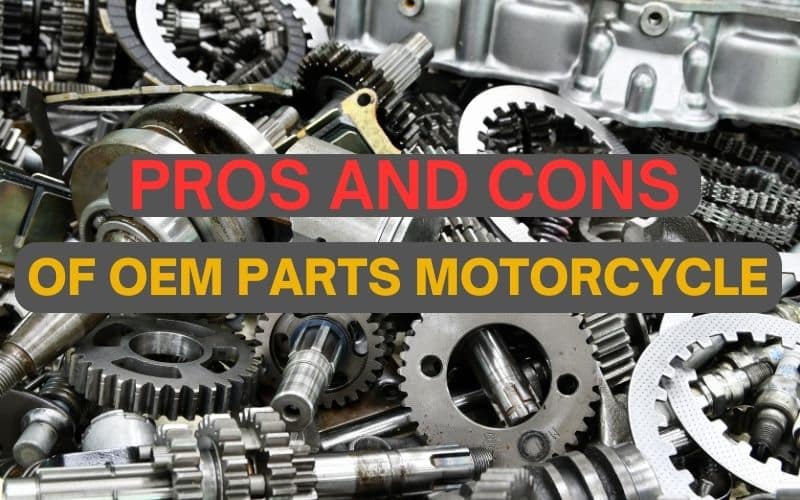When it comes to maintaining and repairing your vehicle, one critical decision you’ll need to make is whether to opt for Original Equipment Manufacturer (OEM) parts or explore the aftermarket alternatives. This choice can significantly impact your vehicle’s performance, longevity, and overall cost of ownership. In this article, we will delve into the Pros and Cons of OEM Parts Motorcycle, shedding light on the advantages and disadvantages of sticking with the manufacturer’s original components. By the end, you’ll have a better understanding of which option suits your needs and budget.
Advantages of OEM Parts Motorcycle
OEM parts, also known as genuine or factory parts, are components specifically designed and manufactured by the original equipment manufacturer. One of the primary advantages of using OEM parts is quality. These parts are built to the exact specifications of your vehicle, ensuring a perfect fit and optimal performance. When you choose OEM parts, you can trust that they meet the same standards and undergo the same rigorous testing as the parts originally installed in your vehicle.
Another key advantage is reliability. OEM parts come with a warranty from the manufacturer, giving you peace of mind in case of defects or issues. Since these parts are made to match your vehicle’s design, you can count on them to work seamlessly with other components, reducing the risk of compatibility problems that can arise with aftermarket parts.
Disadvantages of OEM Parts
While OEM parts offer quality and reliability, they often come at a higher cost compared to aftermarket alternatives. The brand name and the assurance of compatibility come with a premium price tag. For budget-conscious consumers, this can be a significant drawback, especially for routine maintenance and minor repairs where aftermarket parts may be a more cost-effective solution.
Additionally, availability can be a challenge with OEM parts, especially for older or less common vehicle models. You may need to wait for the parts to be shipped from the manufacturer or a dealership, potentially causing delays in your vehicle’s repair process. In contrast, aftermarket parts are often more readily available and can be sourced locally, reducing downtime.
My Top Recommended Tools & Supplies — CLICK HERE! I highly recommend these motorcycle tools for their affordable yet top-notch quality, reflecting my extensive 50+ years of motorcycling experience and expertise as a rider, leader, and consultant in 25+ countries. So, whether you're a seasoned rider seeking an upgrade or a new enthusiast starting your journey on two wheels, I'm confident that these gear recommendations will serve you exceptionally well. |
Aftermarket Vs. OEM Parts
When comparing aftermarket and OEM parts, it’s essential to consider both price and performance. Aftermarket parts are typically more affordable, making them an attractive option for those looking to save money. However, the lower cost can sometimes be a trade-off for quality and fit. Aftermarket parts may not meet the same quality standards as OEM parts, and compatibility issues can arise, leading to potential problems down the road.
Choosing between aftermarket and OEM parts ultimately depends on your specific needs and budget. If you’re driving an older vehicle and need to replace a basic component, aftermarket parts may be a practical choice. On the other hand, if you own a newer vehicle or require critical components, investing in OEM parts is a safer bet to maintain your vehicle’s performance and resale value.
Choosing the Right Parts
Selecting the right parts for your vehicle involves careful consideration of several factors. Begin by assessing your budget and the nature of the repair or maintenance required. If it’s a minor fix or you’re working on an older vehicle, aftermarket parts may offer a cost-effective solution. However, for major repairs or if you own a newer vehicle under warranty, OEM parts are often the recommended choice.
Next, research is essential. Understand the specific parts you need and gather information on both OEM and aftermarket options. Read reviews, consult with professionals, and seek recommendations from experienced mechanics. A well-informed decision can save you time and money in the long run.
Cost Considerations
Cost considerations play a significant role in your choice between OEM and aftermarket parts. While OEM parts tend to be more expensive, they come with the assurance of quality and compatibility. On the other hand, aftermarket parts are often more budget-friendly but may require additional research and scrutiny to ensure they meet your vehicle’s requirements.
Remember that the total cost of ownership includes not only the initial purchase price of the parts but also potential future repair and maintenance costs. Investing in quality OEM parts upfront can reduce the likelihood of costly repairs down the road, ultimately saving you money in the long term.
In conclusion
The decision to use OEM or aftermarket parts for your vehicle is not one-size-fits-all. It hinges on factors such as your budget, the specific repair or maintenance needs, and your long-term objectives for your vehicle. Weigh the pros and cons carefully, conduct thorough research, and seek professional advice when necessary to make an informed choice that ensures your vehicle’s longevity and performance.
 I've diligently categorized my motorcycle gear recommendations into all available categories, with the aim of providing you with a comprehensive analysis that showcases the absolute best options for all your needs. These items are the culmination of in-depth research, extensive testing, and personal use throughout my vast experience of 50+ years in the world of motorcycling. Besides being a passionate rider, I've held leadership positions and offered consultancy services to reputable companies in over 25 countries worldwide. To See Our Top Picks and the Best Prices & Places to Buy: Click Here! |
Ni/TP-Ai

